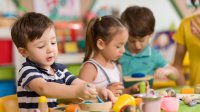Bringing Project-Based Learning to Preschool
Young children’s natural curiosity lends itself well to PBL—and with the right supports, these projects can be extremely effective.
Your content has been saved!
Go to My Saved Content.Project-based learning (PBL) provides an interesting challenge for preschool teachers because it extends beyond early-childhood education mainstays such as teacher-directed themed crafts and short daily lessons.
PBL, which focuses on children learning through investigating a topic or answering a question, is an involved process that could last for as long as the children show interest. Facilitating PBL is easier when teachers pick something to explore based on the children’s interests and implement their ideas in the project. When children are engaged in the process, they naturally develop skills they can apply later in life.
Young Filmmakers
While teaching preschool in Seattle, my co-teacher and I observed some children playing cats and dogs in the drama area. We sat with that small group of children and talked about their play. The children expressed that they wanted to make cat and dog masks.
To honor their request, we propped up real pictures of cats and dogs and gave the children a variety of materials. While we filmed the children with their masks, they asked to make a movie! At first, I didn’t know how to make that happen, which led to the question, “How do we make a movie?”
During free choice, we pulled the small group of children for 15 minutes a day and asked them for ideas. They made the script and chose the film location outside. They even picked the title, A Dog’s Story: A Dog’s Life. The sessions grew longer as the children worked on their costumes and did rehearsals.
After two weeks of prepping, filming day finally came. We put a camera on a tripod, and the children took turns filming. They acted out their scenes and said their lines, which we read aloud and they repeated. I put together the final scenes with their choice of music. The children made movie premier posters and wrote invitations for families. They picked the snacks and set up the viewing area.
From an adult’s viewpoint, it was quite a bizarre movie with an odd plot of masked children jumping out of bushes and saying funny things. The ending was everyone on all fours meowing and barking. However, the children were so proud when their families came and watched the movie. Our final step was to create a learning story showing how we touched on all learning domains (math, literacy, language, social and emotional, drama, etc.).
4 Keys to Effective PBL in Preschool
1. Teachers create the opportunities. One way to start setting up PBL is to create a classroom culture of innovation. A teacher’s viewpoint on children’s capabilities is important. The children are inventors, architects, actors, artists, scientists, or engineers. They are capable of doing amazing things with the right space, materials, tools, and time, which is why creating indoor and outdoor spaces with a variety of open materials is so crucial.
2. Observe the children to find your topic or question. Once the environment is established, a teacher needs to intentionally watch and listen. This can be during large group, free choice, and outside time. It’s capturing an experience, seeing recurring play, or noticing a comment. How can we make our hot wheels go faster? How do birds make nests? How do you make a rocket ship?
3. Teachers are the project managers. Once a teacher picks a question or topic, they need to see themselves as a facilitator and organizer of the children’s plans. Young children have minimal experience and limited access to resources, materials, and information. They’re still learning how to get along with others. Teachers will need to model the process and maybe even take on some of the work that’s outside of preschool students’ abilities, such as conducting online research and using tools like glue guns.
4. Children generate the ideas. To start the project, the teachers can have an open discussion on the topic and write down all the children’s responses. What do we know? What do we want to know? How will we learn it? What steps do we need to take? What materials do we need? If the children are stumped, it’s OK to make suggestions for them to consider. Posting the children’s ideas shows them that their thoughts and concepts have value. The teacher’s next job is to make the children’s plans come to life—no matter how it may look at the end!
We tend to think PBL is better suited for older children, but preschool-age children are very capable. They just need opportunity. Children are eager to be a part of something big by creating things and solving problems. As a teacher models project planning, they show children how to work as a team, create a plan, and execute collaborative ideas. The focus should be on the process rather than the final product. Our dog movie may not be Academy Award worthy, but the skills and confidence gained by the children were the true gift. It will always be one of my favorite (and most hilarious) moments in teaching.
